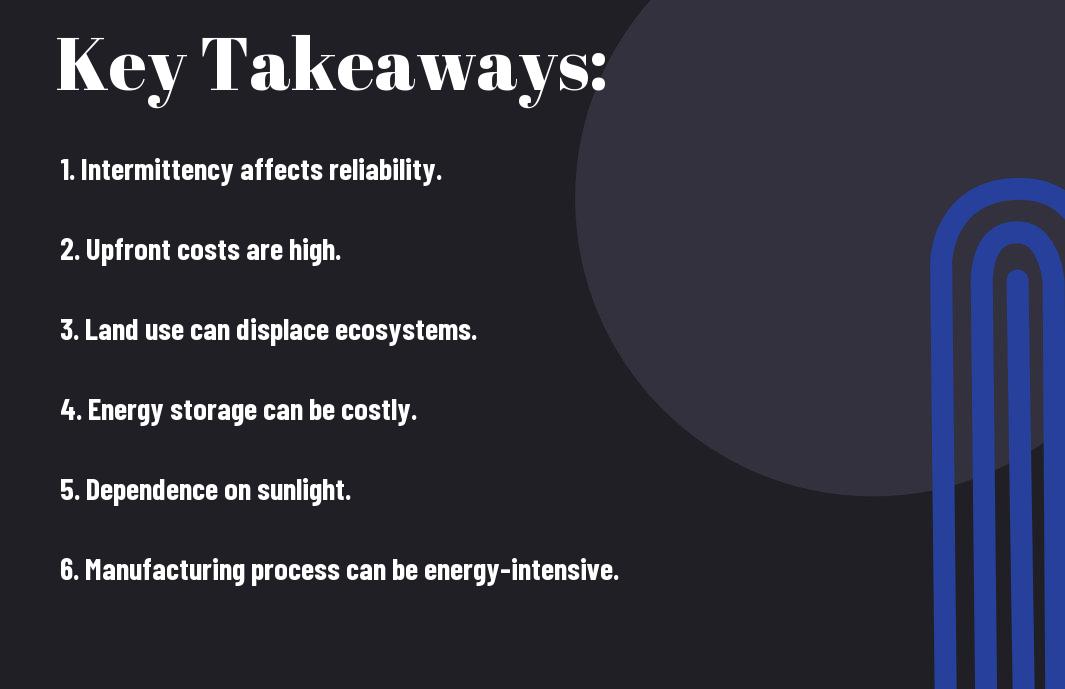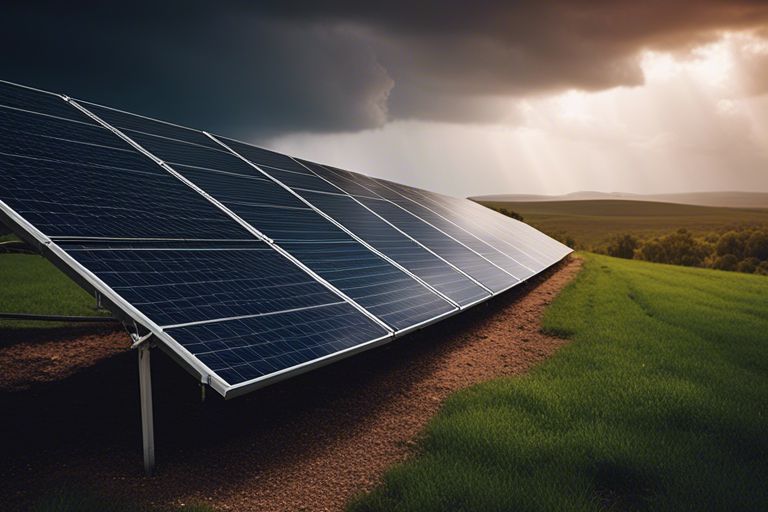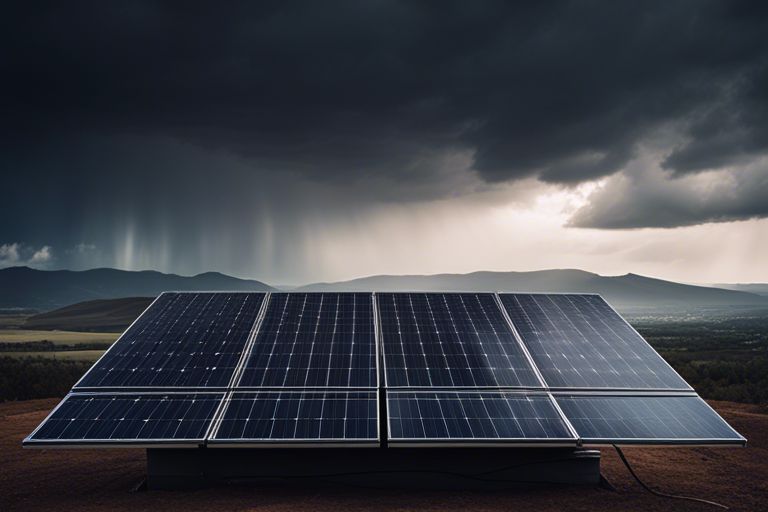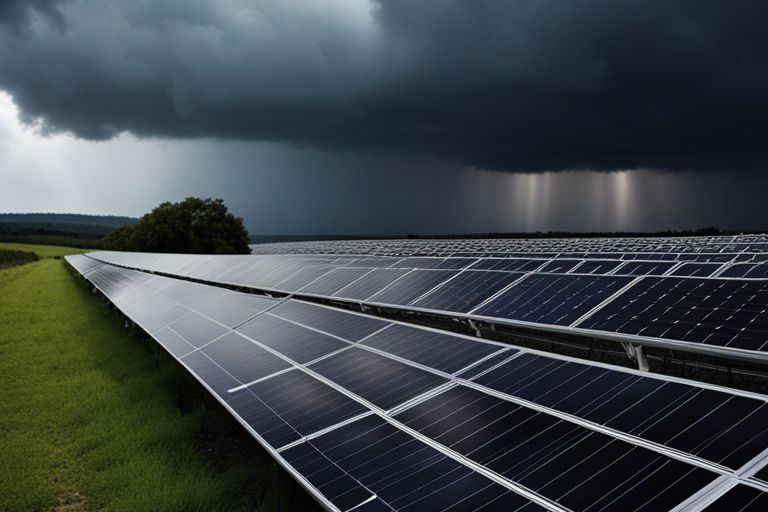It’s time to shed light on the dark side of solar power. While solar energy is praised for its sustainability and efficiency, there are drawbacks you should be aware of. From its high initial costs to its intermittent nature, solar power has its limitations. By understanding these two negatives of solar power, you can make informed decisions about whether it is the right choice for your energy needs.
Key Takeaways:
- Intermittency: Solar power generation is affected by weather conditions, making it an intermittent source of energy.
- Energy Storage: The need for effective energy storage solutions adds to the overall cost of solar power systems.


Limited Energy Generation
Before delving into the negatives of solar power, it’s crucial to understand that one issue with this renewable energy source is its limited energy generation capacity. Solar power relies on the sun’s availability, meaning that energy production is primarily during daylight hours. Once the sun sets, energy production ceases until the next day. This can result in challenges meeting the demand for electricity during evening hours when consumption tends to peak.
Intermittent Power Supply
One downside of solar power is its intermittent nature. Cloud cover, inclement weather, or even something as simple as the angle of the sun can affect the amount of sunlight reaching solar panels, leading to fluctuations in energy production. This variability can make it challenging to rely solely on solar power for consistent energy needs.
Dependence on Weather Conditions
To add to the intermittent supply concern, solar power systems are dependent on weather conditions. While sunlight is a free and abundant resource, its availability can be inconsistent based on factors like seasonal changes, cloud cover, and geographical location. This dependence on weather conditions can impact the reliability of solar power as a continuous energy source.
Intermittent power supply due to weather variability can pose challenges in ensuring a stable energy supply for your needs. While advancements in energy storage solutions like batteries can help mitigate this issue, they can add to the overall cost of a solar power system.
High Upfront Costs
Clearly, solar power has numerous advantages, but there are also some negatives to consider. One of the main drawbacks is the high upfront costs associated with setting up solar panels for your home or business. According to Advantages & Disadvantages of Solar Energy article, the initial investment in infrastructure can be quite significant, deterring some individuals from switching to solar energy.
Initial Investment in Infrastructure
An initial investment in solar panels, inverters, batteries, and installation can be expensive. While there are government incentives and rebates to help offset some of these costs, the overall price tag can still be a barrier for many people.
Cost of Maintenance and Repair
An ongoing concern with solar power is the cost of maintenance and repair. Solar panels require regular cleaning and inspection to ensure they are functioning efficiently. If something goes wrong with your solar system, repairs can also be costly and may not always be covered by warranty.
Maintenance and repair costs should be factored into your decision to invest in solar power, as they can add up over time and impact the overall affordability of solar energy.
Land Requirements
Large Area Needed for Installation
Not only does solar power require a significant amount of land for installation, but the amount of land needed can vary depending on the location and type of solar panels used. For example, utility-scale solar farms can cover hundreds of acres of land, which may not be feasible in densely populated areas where land is scarce and valuable.
Potential Environmental Impact
Large-scale solar installations can have a potential environmental impact on the surrounding ecosystems. Clearing land for solar farms can disrupt local habitats and wildlife, leading to fragmentation and loss of biodiversity. Additionally, the materials used in solar panels, such as silicon and cadmium telluride, can have environmental consequences if not properly managed at the end of their lifespan.
This environmental impact can be mitigated by conducting thorough environmental impact assessments before construction begins, implementing proper land management practices, and investing in recycling programs for solar panel components. By being mindful of these potential impacts, you can help ensure that the benefits of solar power outweigh its negatives.

Energy Storage Challenges
Limited Battery Capacity
To effectively harness solar power, you need a reliable way to store excess energy generated during the day for use when the sun isn’t shining. One of the major challenges with solar power is the limited capacity of current battery technology to store this energy efficiently. This means that you may not have enough stored power to sustain your energy needs during the night or on cloudy days, leading to a reliance on alternative energy sources.
High Cost of Energy Storage Solutions
To fully embrace solar power and make the most of its benefits, you must invest in energy storage solutions such as batteries. However, one significant drawback is the high cost associated with these storage options. The initial investment in batteries can be substantial, making it challenging for many households or businesses to afford the necessary storage capacity to store surplus solar energy effectively.
On top of the high upfront costs, you must also consider the maintenance expenses that come with energy storage solutions. Regular maintenance and replacement of batteries can add to the overall cost of your solar power system, making it a less attractive option for some individuals or organizations.
Another factor to consider when it comes to the high cost of energy storage solutions is the technological advancements in battery technology. As new and more efficient batteries are developed, you may find yourself wanting to upgrade your storage system to take advantage of the latest innovations. This continuous cycle of upgrading can further add to the overall cost of utilizing solar power in your daily energy consumption.
Grid Integration Issues
Inconsistent Power Output
After reading about The Advantages and Disadvantages of Solar Energy, you may have learned that one of the drawbacks of solar power is its inconsistent power output. Solar energy production is heavily dependent on weather conditions, such as sunlight availability and cloud cover. This variability can lead to fluctuations in the amount of electricity being generated, which can pose challenges for grid operators in managing a stable power supply.
Strain on Existing Grid Infrastructure
On the topic of grid integration issues, another concern with solar power is the strain it can put on existing grid infrastructure. The growing adoption of solar energy systems means an increased need for grid upgrades and investments to accommodate the bi-directional flow of electricity between homes and the grid. As more households become prosumers, generating and consuming their own electricity, the infrastructure will need to evolve to handle this new dynamic.
Inconsistent power output from solar systems can create imbalances in supply and demand on the grid, requiring adjustments in real-time to prevent blackouts or grid failures. This necessitates upgrades to grid systems and the implementation of energy storage solutions to help stabilize the grid and ensure reliable electricity supply.
Technology Limitations
Now let’s examine into the technology limitations of solar power. Two key negatives to consider are efficiency rates of solar panels and the limited ability to meet peak energy demand.
Efficiency Rates of Solar Panels
Limitations in solar panel efficiency can hinder the overall effectiveness of solar power systems. While advancements have been made in improving the efficiency of solar panels, current technology still falls short of capturing and converting all available sunlight into electricity. This means that not all of the sunlight that hits the solar panels can be converted into usable energy for your home or business, resulting in a loss of potential power generation.
Limited Ability to Meet Peak Demand
Solar power systems rely on sunlight to generate electricity, which may not always align with peak energy demand times. This mismatch between peak energy usage periods, typically in the early mornings and evenings, and peak sunlight hours during the day, can pose a challenge for solar power systems. As a result, solar power alone may not be sufficient to meet your peak energy demands, requiring additional sources of power or energy storage solutions to bridge the gap.
With advancements in energy storage technologies like batteries, the issue of limited ability to meet peak demand can be mitigated to some extent. By storing excess solar energy generated during the day, you can use it during peak demand times when sunlight is not readily available. However, these storage solutions come with their own set of limitations and costs to consider.
Summing up
With this in mind, you can see that two negatives of solar power are the high initial costs of installation and the intermittent nature of solar energy. While solar panels have become more affordable over the years, the upfront investment can still be a barrier for many people. Additionally, because solar power is reliant on the availability of sunlight, it may not always be a consistent source of energy, especially in areas with frequent cloud cover or during nighttime hours.
FAQ
Q: What are two negatives of solar power?
A: While solar power is a relatively clean and renewable energy source, there are a few drawbacks to consider:
- Intermittency: Solar power is dependent on sunlight, which means it is not consistently available at all times, such as during nighttime or on cloudy days. This variability can make it challenging to rely solely on solar power for all energy needs.
- Upfront Costs: The installation of solar panels and related equipment can be expensive, requiring a significant upfront investment. While long-term savings on energy bills can offset these costs, the initial expense may be a barrier for some individuals or businesses.
Q: Are there any environmental concerns associated with solar power?
A: While solar power is considered a clean energy source, there are some environmental considerations to keep in mind:
- Manufacturing Impact: The production of solar panels and related equipment can generate greenhouse gas emissions and produce waste. Additionally, the mining of materials used in solar panels, such as silicon and rare earth minerals, can have environmental consequences.
- Land Use: Large-scale solar farms can require significant amounts of land, which may impact local ecosystems and biodiversity. Careful planning and consideration of land use are important to minimize these effects.
Q: How can the negatives of solar power be mitigated?
A: There are several strategies to address the drawbacks of solar power:
- Energy Storage: Implementing energy storage systems, such as batteries, can help store excess solar energy for use during times when sunlight is not available, increasing reliability and stability of solar power.
- Technological Innovation: Continued advancements in solar technology, such as increased efficiency of panels and improved manufacturing processes, can help reduce costs and environmental impacts associated with solar power.
